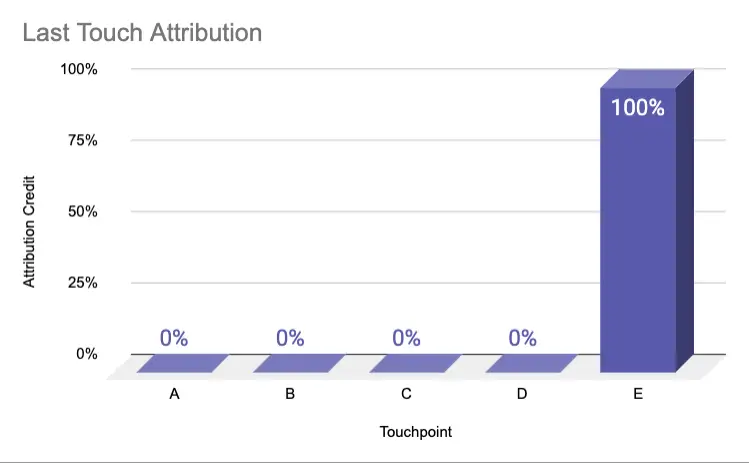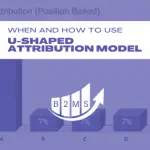Is first touch or last touch the best single touch attribution?
Single Touch Attribution is a type of marketing attribution model that assigns all credit for a conversion or sale to a single touchpoint in the consumer journey. This means that regardless of how many other touchpoints are involved, only the first or last one will be given recognition and receive credit for the purchase. While this model can be beneficial in some cases, it should not be used as the only means of attribution.
For example, if a customer visits an online store and then leaves without making a purchase, but later comes back to make a purchase after seeing an advertisement on social media, Single Touch Attribution would assign all credit for the sale to either the initial visit or the ad campaign depending on which attribution model you selected.

First touch attribution model
First touch attribution models assign 100% of the credit to the very first marketing touchpoint with a user. It doesn’t take the number of interactions or time between the first touch and becoming a customer.
First-touch attribution is helpful for businesses that want to focus on the original source of a lead or conversion. It can also help identify opportunities to improve existing campaigns, as it allows you to see which channels are working best at driving initial interest in your product or service.
Advantages of first touch attribution
First touch attribution models have some important advantages when it comes to attribution reporting and understanding the impact of your marketing campaigns:
- Easy to set up: First touch attribution reporting is often the out-of-the-gate attribution solution within your advertising platforms like Google Ads, Facebook Ads, or LinkedIn Ads. It’s also totally free to implement in Google Analytics. CRM systems like HubSpot report by default on the original source.
- First touch attribution is easy to understand: You know exactly what you are looking at. It’s the first interaction that a user had with your marketing (excluding any non-click action like the view of a display advertisement.)
- Taking actions on the data: Because it’s easy to set up and understand, marketers can optimize towards channels that generate net new leads.
First touch vs last touch attribution
Last touch attribution – in contrast to the first touch – gives the entire credit to the last marketing touchpoint instead of the very first one.
Last touch attribution can be distinguished between two methods: Last click or last non-direct click attribution. The last non-direct click attribution is a common attribution model used in tools like Google Analytics that give credit to the last touchpoint that was not coming for the direct traffic source.
The last touch attribution model is useful if you want to recognize where the customer was when they made the conversion, and it can be used to identify any opportunities for improvement in the customer journey.

Example of first touch vs last touch attributions
Let’s assume someone clicked a Facebook ad to come to your website, then leaves without completing a purchase. Later, the same user finds your website via an organic Google search and lands on a blog post. Finally, that user comes back by visiting your website directly to convert into a customer.
User touchpoints | First touch attribution | Last touch attribution | Last non-direct click attribution |
Clicks Facebook ad | 100% | – | – |
Visits blog post from organic search | – | – | 100% |
Visits website directly and completes purchase | – | 100% | – |
In this simplified example, you can see that each of the three single touch attribution models give 100% credit to different user interaction, even though it’s the same user.
Problems with single touch attribution models
The main problem with single touch attribution models is that they don’t consider the full customer journey or the impact of other channels. For example, in our example scenario above, a first-touch attribution model would assign all credit for the conversion to the Facebook ad even though it was not directly responsible for the conversion.
In addition, single touch attribution models do not take into account the time between interactions or any potential purchases that may have been made in the interim. This means that a customer who spends weeks or months researching products or services before making a purchase will not be accurately represented under this model.
Overall, both attribution models overemphasize the top of the funnel or bottom of the funnel, respectively.
Alternatives to first touch and last touch attribution models
Single touch attribution models have limitations when it comes to visualizing the customer journey. In order to attribute credit along the entire user flow, marketers use multi-touch attribution (MTA). Similarly, here we can distinguish between different MTA categories and models: Linear, position-based, and data-driven multi-touch attribution. Position based models are usually described the letters that form the attribution graph: U-shaped, W-shaped, and Z-shaped.
Now that we understand the different attribution models, we can define when we should use first touch attribution and/or last touch attribution models.
When should you use first touch attribution?
First-touch attribution assigns 100% of the credit to your business’s initial contact with a customer. It makes perfect sense – in order for customers to buy something from you, they must be aware that you exist. This model thus prioritizes strategies like making people conscious of your brand and attracting potential buyers. Without these approaches, no sales can be made – so it is essential to remain cognizant of first-touch best practices.
With first-touch attribution, you can concentrate more of your marketing budget on initial funnel activities. This will not only expand the knowledge about your brand but also draw in potential customers at a faster rate and drive up sales opportunities. Not just does this model appear to have an understandable structure, but it’s easy to set up as well. You don’t even need to follow their full journey – simply recognizing the moment when they come across you for the first time would be enough.
Overall, the more you focus on where the first contact is made, the more important is the first touch attribution model.
Secondly, the more transactional your offering is, and the shorter your sales cycle is, the more value the first touch attribution model has.
When should you use last touch attribution?
Last touch attribution has the downside that it only takes into account the very last interaction, regardless of how many touchpoints have prompted the sale or conversion. On the other side, it also has some advantages and important use cases. Marketers should use the last touch attribution reporting when they have already a lot of traffic and leads, but need to optimize the last step in the sales funnel.
Moreover, if brands have a high amount of interest in their low-intent (informational) content.
Additionally, another use case is a long sales cycle. If you can identify high converting marketing touchpoints, you can optimize those and convert leads soon and more often.
When to choose multi-touch attribution?
The more complex and unique a customer journey and sales process is, the more benefits the multi-touch attribution method has. It emphasizes the entire user journey. However, it is hard to set up and taking action from the presented data.
Multi-touch attribution usually finds more adoption in B2B lead attribution and generation.

Sascha is a Lifecycle Marketing Consultant with over 8 years of digital marketing experiences in Silicon Valley, the UK, and Germany.
After leading the demand generation for a 100+ million company, he decided to venture out on himself. He’s now helping clients to attract and convert more leads and customers.
His main focus are SEO, paid media & marketing automation – all with the focus to tie marketing campaigns to revenue.
Sascha has been featured in industry publications.




